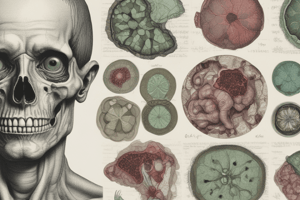Podcast
Questions and Answers
Which type of necrosis is characterized by the release of proteolytic enzymes from neutrophils?
Which type of necrosis is characterized by the release of proteolytic enzymes from neutrophils?
- Liquefactive necrosis (correct)
- Fat necrosis
- Caseous necrosis
- Coagulative necrosis
In which type of necrosis is the gross appearance similar to cheese?
In which type of necrosis is the gross appearance similar to cheese?
- Caseous necrosis (correct)
- Coagulative necrosis
- Liquefactive necrosis
- Fibrinoid necrosis
Which type of necrosis involves the formation of calcium soaps due to the attraction of Ca from the blood?
Which type of necrosis involves the formation of calcium soaps due to the attraction of Ca from the blood?
- Fat necrosis (correct)
- Fibrinoid necrosis
- Liquefactive necrosis
- Coagulative necrosis
Which type of necrosis is most commonly seen in the walls of blood vessels, such as in vasculitis?
Which type of necrosis is most commonly seen in the walls of blood vessels, such as in vasculitis?
Which type of necrosis preserves the cell's basic outline but loses details due to protein denaturation predominating enzymatic digestion?
Which type of necrosis preserves the cell's basic outline but loses details due to protein denaturation predominating enzymatic digestion?
Which type of necrosis is usually due to enzymatic dissolution of necrotic cells, often caused by the release of proteolytic enzymes from neutrophils?
Which type of necrosis is usually due to enzymatic dissolution of necrotic cells, often caused by the release of proteolytic enzymes from neutrophils?
Which type of necrosis involves the formation of glassy, eosinophilic fibrin-like material within the vascular walls, and is usually seen in vasculitis?
Which type of necrosis involves the formation of glassy, eosinophilic fibrin-like material within the vascular walls, and is usually seen in vasculitis?
Which type of necrosis is characterized by the preservation of the cell's basic outline but the loss of details due to protein denaturation predominating enzymatic digestion?
Which type of necrosis is characterized by the preservation of the cell's basic outline but the loss of details due to protein denaturation predominating enzymatic digestion?
Which type of necrosis involves the release of triglycerides that are hydrolyzed by lipase into fatty acids and glycerol, leading to the formation of calcium soaps?
Which type of necrosis involves the release of triglycerides that are hydrolyzed by lipase into fatty acids and glycerol, leading to the formation of calcium soaps?
In which type of necrosis does the gross appearance resemble cheese and is usually seen in infections, especially mycobacterial (TB) and fungal infections?
In which type of necrosis does the gross appearance resemble cheese and is usually seen in infections, especially mycobacterial (TB) and fungal infections?
Flashcards are hidden until you start studying





